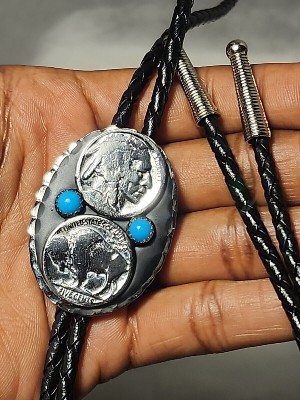Affiliate Disclaimer: We work to provide bolo ties and locate merchants who sell the products you are looking for. If you make a purchase from any of the merchants we endorse, we will earn a small commission at no additional cost to you. Thank you for your support!
Buffalo Nickel Bolo Ties: Fashioned by sculptor James Earle Fraser in 1912

Buffalo Nickel History
For the United States mint, sculptor James Earle Fraser created the Buffalo Nickel (also known as the Indian Head Nickel) in 1912. Coined as part of the Mint's effort to improve the aesthetics of American currency, this piece featured a striking likeness of a Native American on one side and a buffalo on the other. From 1913 until 1938, it was struck in the Philadelphia, Denver, and San Francisco Mints.
On February 22, 1913, the mint in Buffalo, New York, began production of the first Buffalo Nickels. At the groundbreaking for the National American Indian Memorial in Staten Island, New York, they were informally released into limited circulation. To show his appreciation to the Native American leaders in attendance, President Taft brought 40 brand-new nickels to the event. (The National American Indian Memorial was never constructed after the groundbreaking event.)
It only took a week after the Buffalo Nickel entered circulation on March 4, 1913, for Chief Engraver Charles Barber to voice his worry over the rapid wear of the manufacturing dies. His calculations showed that Buffalo Nickel dies wore out and broke three times as quickly as Liberty Head Nickel dies. Barber, along with other Mint employees, predicted that the Buffalo Nickel's date and "FIVE CENTS" marking would quickly become unreadable after being subjected to normal use. Barber produced many adjustments to the design to address these issues, and when Fraser gave his stamp of approval, the significantly redesigned Buffalo Nickel entered production. Despite Barber's efforts, the dies began to wear down much more quickly when his adjustments were implemented.
From 1913 through 1938, a whole quarter century was devoted to minting Buffalo Nickels. The Mint held a contest in 1938 to replace the Buffalo Nickel as soon as they could legally do so. In November of 1938, the first Jefferson Nickels were released.
What year Buffalo Nickel is worth the most?
The Top 7 Most Valuable Nickels
S Buffalo Nickel. 1926. $322,000.
Buffalo Nickel. 1916. $281,750.
D Buffalo Nickel. 1913. $143,750.
S Buffalo Nickel. 1917. $138,000.
D Buffalo Nickel. 1920. $138,000.
Shield Nickel. 1867. $132,250.
S Buffalo Nickel. 1918. $125,350.
The buffalo nickel, also known as the Indian Head nickel, was minted by the United States Mint from 1913 to 1938. It is considered by many to be one of the most beautiful and iconic American coins ever produced. The obverse depicts a Native American chief, believed to be based on three different Native American men. The reverse features an American bison. Both designs were created by sculptor James Earle Fraser.
This coin gets its name from the American bison featured on the reverse. The buffalo nickel was introduced in 1913, replacing the Liberty Head nickel that had been in use since 1883. It was minted until 1938, when it was replaced by the Jefferson nickel we still use today.
Popularity and Mass Production
Over 1.2 billion buffalo nickels were produced during this time, meaning the coins are plentiful and inexpensive in lower grades.
Valuable Dates and Mint Marks
However, some buffalo nickels are highly sought after by collectors and can be worth significant sums in mint state condition. This is due to a couple key factors. For one, there are a few particularly scarce dates and mint marks. The 1916-D and 1926-S issues are notorious rarities that can trade for thousands of dollars if in pristine condition. There are also a handful of overdates, where an old date was repunched with a newer one, that are valuable.
Importance of Full Horns
The other reason certain buffalo nickels are expensive is due to the issue of full horns. During the almost 30 year run of the series, the buffalo's horns became worn and blunted on the coin dies. Full horn versions, where the horns are sharp and detailed, are much more desired by collectors than the rounded, worn down horn versions. This can mean a difference of hundreds or even thousands of dollars for the same date and mint buffalo nickel.
Most Valuable Examples
The most expensive buffalo nickel ever sold was a 1918/7-D overdate that graded PCGS MS66 and realized $4.56 million in 2019! This unique coin has almost impossibly sharp detail.
The End of the Series
The last official buffalo nickels were struck in 1938 at the San Francisco mint. However, a small number of 1913-dated pieces were illegally struck by a mint employee in the early 1960s. These unauthorized pieces are also highly valuable today.
Conclusion
The buffalo nickel series offers something for every budget, from well-worn affordable examples to pristine gems worth a small fortune. For coin collectors and history lovers alike, the buffalo nickel remains one of America's most endearing vintage coins.

Buffalo Nickel Bolo Ties for Sale
References
James Earle Fraser (sculptor) - WikipediaBuffalo Nickel - All About Bison
The intriguing history of the rare buffalo nickel
A Brief History of the Nickel - Smithsonian Magazine
NGC Coin Explorer - Buffalo Five Cents (1913-1938)
PCGS CoinFacts - Buffalo Nickels
USA Coin Book - Buffalo Nickels
Coin Values - Buffalo Nickels
Coin Community - Buffalo Nickel Links and Resources
JM Bullion - Buffalo Nickels for Collectors
Collectors Corner - Buffalo Nickel Collectibles








